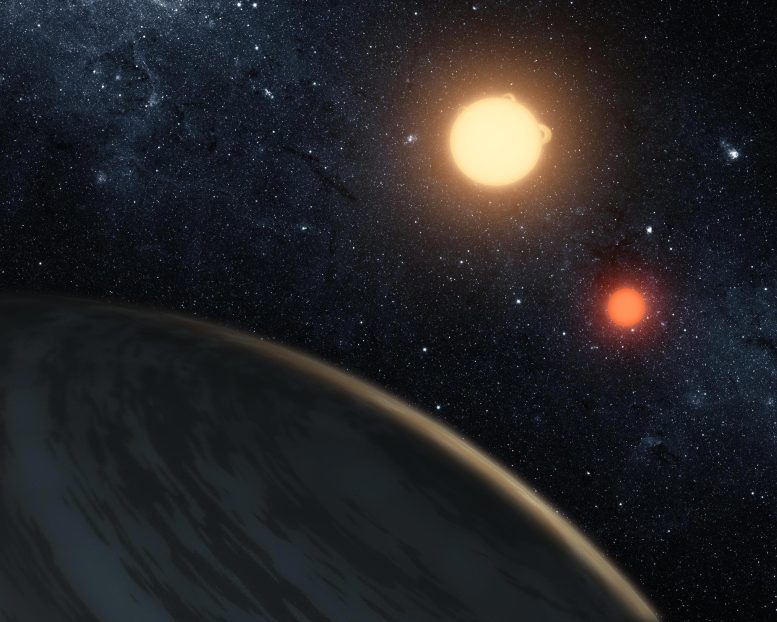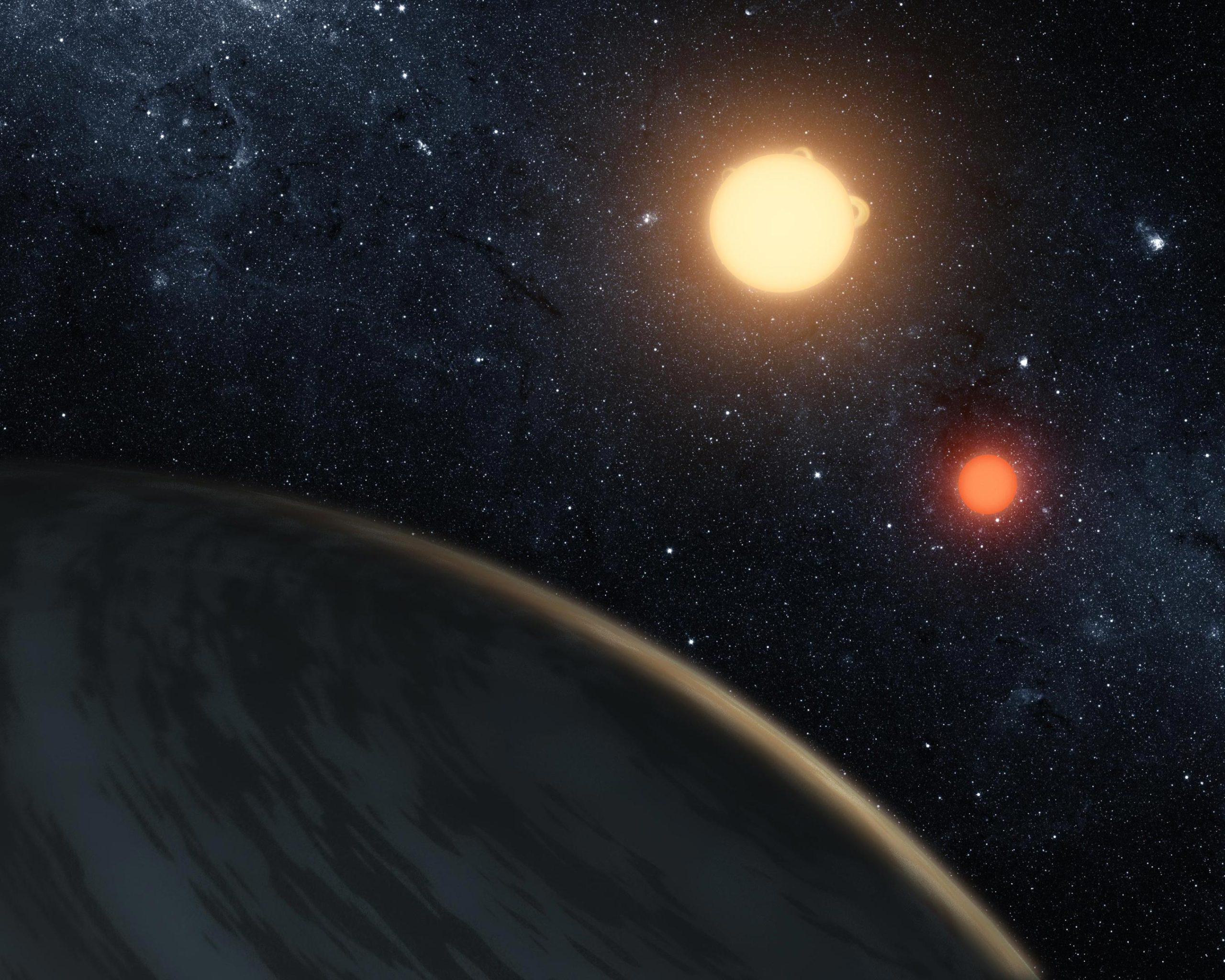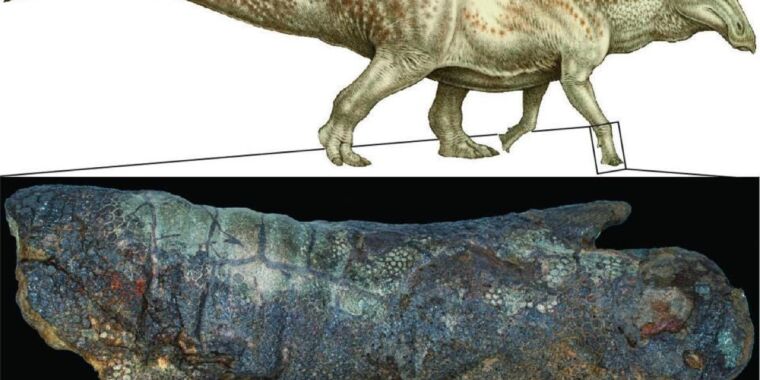
두 개의 별을 완전히 공전하는 것으로 알려진 최초의 행성인 Kepler-16b에 대한 아티스트의 인상, 이른바 고리 행성입니다. 전경에서 볼 수 있는 이 행성은 NASA의 케플러 임무에 의해 발견되었습니다. 출처: NASA/JPL-Caltech/T. Pyle
이 연구는 지상 망원경이 두 개의 태양을 가진 행성을 찾을 수 있음을 증명합니다.
천문학자들은 새로운 기술을 사용하여 “스타워즈”에서 루크 스카이워커의 고향이었던 두 개의 태양이 있는 가상의 행성인 타투인의 실생활을 확인했습니다.
케플러-16b 행성은 지구에서 약 245광년 떨어져 있으며 크기는 약[{” attribute=””>Saturn. Scientists already knew that the planet existed, but in a recent study, an international team of astronomers explained how they successfully applied a technique that hadn’t been previously used to observe a planet orbiting two stars.
“It’s a confirmation that our method works,” said David Martin, co-author of the study and NASA Sagan Fellow in The Ohio State University’s Department of Astronomy. “And it creates an opportunity for us to apply this method now to identify other systems like this.”
The technique, called the radial velocity method, has long been used in astronomy. (The first planet ever found around a sun-like star was found using radial velocity – and was found using the same telescope astronomers used to find this one.)
The radial velocity method involves analyzing the spectra of light produced by the stars. Astronomers gather spectra data through telescopes on the ground – in this case, from a telescope based in France, the Observatoire de Haute Provence. That spectra data graphs into a line, but the line “wobbles” as the planet orbits around the two stars, producing a shaky line in the spectra of light. The wobble indicates a planet is there, and astronomers can use it to derive a number of other pieces of information about a planet, including its mass.
Measuring radial velocity is, Martin said, among the best tools astronomers have to identify exoplanets, or planets outside our solar system. But until this study, astronomers had not been able to use it to find planets outside our solar system that orbit two stars.
The study was published this week in the Monthly Notices of the Royal Astronomical Society.
In the past, such planets – known as circumbinary planets – were identified by monitoring when one star passed in front of the other. That method, known as the “transit method,” has identified 14 such planets, including Kepler-16b. The first confirmed circumbinary planet was described in a paper in 2011; others have followed. But until this paper, none had been found using radial velocity.
“What people had faced was that having two sets of spectra from two stars makes it really tricky, and people were struggling to get enough precision to see the wobble caused by the planet,” Martin said. “And we got around that by making a survey of systems with two stars that orbit each other where one star is big, and one is quite small.”
The survey, called Binaries Escorted by Orbiting Planets, or BEBOP, was established specifically to search for planets like this one.
One of Kepler-16b’s stars is about two-thirds the mass of Earth’s sun, and the other is about 20% the mass.
Astronomers had been watching this system since July 2016.
Proving that measuring radial velocities can identify planets that orbit two stars, Martin said, opens the door for the technique to be applied more broadly. That is important to astronomers for a number of reasons, but a big one is that planets that orbit two stars tend to exist at a distance that would make them good candidates for life.
“These planets are frequently found in the habitable zone, at a distance from the stars where you would expect to find liquid water,” Martin said.
Kepler-16b, which is made primarily of gas, is not likely to be a candidate where life could be found, Martin said. But using the radial-velocity method could help astronomers find other similar planets.
Reference: “BEBOP III. Observations and an independent mass measurement of Kepler-16 (AB) b – the first circumbinary planet detected with radial velocities” by Amaury H M J Triaud, Matthew R Standing, Neda Heidari, David V Martin, Isabelle Boisse, Alexandre Santerne, Alexandre C M Correia, Lorena Acuña, Matthew Battley, Xavier Bonfils, Andrés Carmona, Andrew Collier Cameron, Pía Cortés-Zuleta, Georgina Dransfield, Shweta Dalal, Magali Deleuil, Xavier Delfosse, João Faria, Thierry Forveille, Nathan C Hara, Guillaume Hébrard, Sergio Hoyer, Flavien Kiefer, Vedad Kunovac, Pierre F L Maxted, Eder Martioli, Nicola J Miller, Richard P Nelson, Mathilde Poveda, Hanno Rein, Lalitha Sairam, Stéphane Udry and Emma Willett, 25 February 2022, Monthly Notices of the Royal Astronomical Society.
DOI: 10.1093/mnras/stab3712
Martin’s portion of this work was funded in part by NASA.

“요은 베이컨과 알코올에 대한 전문 지식을 가진 닌자입니다. 그의 탐험적인 성격은 다양한 경험을 통해 대중 문화에 대한 깊은 애정과 지식을 얻게 해주었습니다. 그는 자랑스러운 탐험가로서, 새로운 문화와 경험을 적극적으로 탐구하며, 대중 문화에 대한 그의 열정은 그의 작품 속에서도 느낄 수 있습니다.”









